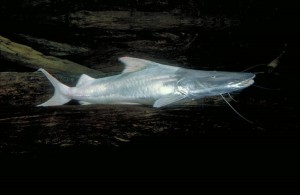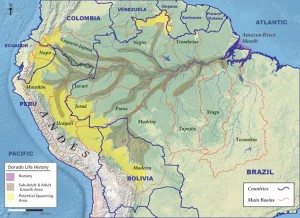Long-Traveling Amazon Catfish
February 17, 2017
Earlier in February, scientists learned that the dorado catfish (also known as the dourada or gilded catfish) of South America has the longest migration of any freshwater fish. These large catfish live in the Amazon River Basin, and their migratory path takes them from the foothills of the Andes Mountains to the mouth of the Amazon River on the Atlantic Ocean, and then back again—a trip of more than 7,200 miles (11,600 kilometers)!

The long-traveling dorado catfish navigates the waters of the Amazon River Basin throughout its life. Credit: © Michael Goulding, Wildlife Conservation Society
Catfish have pairs of fleshy whiskerlike growths near the mouth. These growths, called barbels, resemble the whiskers of a cat. Catfish differ from most other fish in that they do not have scales. Catfish live in many different places around the world, and they come in a variety of shapes and sizes. The dorado catfish (Brachyplatystoma rousseauxii) is just one of several different species (kinds) of catfish that live in the Amazon River and its many tributaries. Dorados can grow beyond 6 feet (2 meters) in length and are grouped with other “goliath” catfish, so named because of their large proportions. Their lengthy migration has long been suspected, but only recently have the details of their epic migratory journey been confirmed. A study of the distribution of larvae, juveniles, and mature dorados showed where the fish tend to be at different stages of life. The study, published in the journal Scientific Reports, was a group effort led by the Wildlife Conservation Society’s Amazon Waters Initiative. Ronaldo Barthem from the Museu Paraense Emílio Goeldi in Brazil led the research team.

This map shows the remarkable migration of the dorado catfish through the Amazon River Basin. Credit: © Wildlife Conservation Society
Barthem and his team found that dorados spawn in the Andes waters of Colombia, Ecuador, Peru, and Bolivia. The larvae then begin a precarious journey downriver, finding their way through such tributaries as the Madeira, the Marañón, and the Rio Negro—all major rivers themselves—to the mighty Amazon itself. The young catfish grow as they travel eastward, following the currents across Brazil to the eventual end of the Amazon north of Marajó Island on the Atlantic coast. There the fish gather in the vast and organically rich waters of the estuary, feeding, growing, and maturing. After a couple years, the fish get the urge to travel back upriver, taking the long swim—another two years—back to the spawning grounds where the life cycle begins again.
Dorados also live in the rivers of Guyana and Venezuela, and they are an important food fish for people throughout the Amazon Basin. Dorado catfish are not an endangered species, but their migration becomes increasingly difficult each year because of damming, deforestation, mining, and pollution.
Salmon and eels are other fish known for their long migrations, but their routes combine saltwater and freshwater routes and still fall short of the long swim of el dorado.


